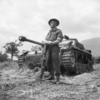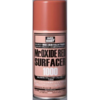TIM FORSTER
SMF Supporter

The well-known photo above shows Fusilier F Jefferson of C Company, 2nd Lancashire Fusiliers in front of the Stug III which he knocked out with a Piat in Italy, 16 May 1944 near Monte Cassino. As a result of his action he won the Victoria Cross.
This vehicle is destined to be part of my WWII diorama 'Liberation, Italy 1944'.
See the blog at: http://www.scale-models.co.uk/threads/liberation-italy-1944.30350/
One of the focal points of my diorama is going to be a KO'ed Stug in front of the church.
There were three reasons why I chose a Stug:
Firstly, the last time I built a Stug in 1/35 I was about 13. That one, a modified Tamiya Stug (which I still have, albeit in a somewhat distressed state) won me a Junior Bronze Medal at the Model Engineering Exhibition at Wembley in about 1982! So this build is pretty nostalgic for me...
Secondly, from what I have seen in books and on-line, the Stug III was practically the mainstay of Axis armour in Italy (as it was on other fronts) and was, of course, ideally suited for the role of defence as the Germans retreated up the peninsula, line-by-line. But inevitably they all succumbed to the Allies in the end.
Thirdly, that distinctive low profile (that made it such an excellent weapon of defence) also meant that it would not get in the way of all of my lovely buildings!


The basis for my build is the Dragon (Smart Kit) D6365 StuG.III Ausf.G early production with Schurtzen.

Of course, the Dragon kit is a world away from the venerable old Tamiya kit which I built back then. But, as we all know, with greater detail comes greater effort - and frustration!
On the face of it the Dragon Stug certainly fits my brief. My diorama is set in the latter half of 1944, following the liberation of Rome in June. By then the Ausf G was already deployed on that front in large numbers and most, if not all, had the square 'box style' mantlet (as opposed to the saukopf 'pig's head' variety). They also had the loader's folding MG shield and lacked the distinctive triangular shot deflector in front of the commander's cupola.
Because my Stug is going to be abandoned with a spilled track and slipping off the road most of the hatches will be open and much of the interior will be visible from the front of the diorama. This certainly adds drama - but it has also added a lot of work!
Now let me make one thing clear from the outset: I firmly believe that what you cannot see should not be modelled. It breaks my heart to see modellers expend hours of effort on vehicle interiors only for them to seal them up like Toutankhamon's tomb!
With this in mind, I thought the Dragon kit would give me a good start. However, I soon discovered that, despite providing a detailed gun assembly, crew radios and torsion bars, there's an awful lot of empty space to be filled - even allowing for my 'less is more' approach. As we shall see...
Last edited:






































